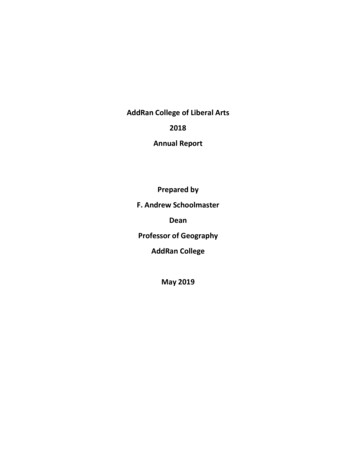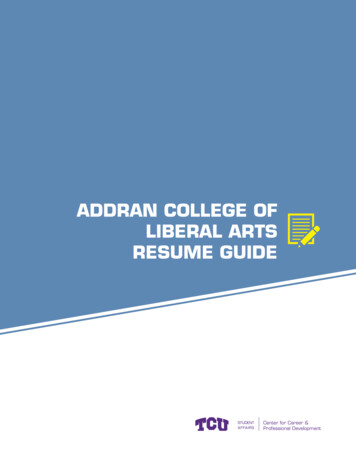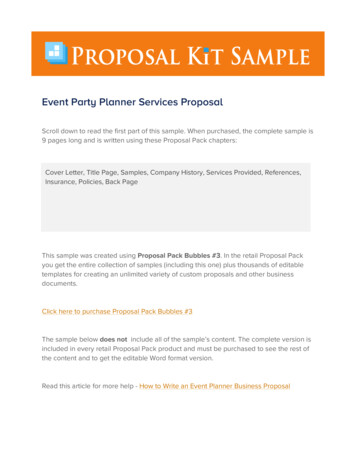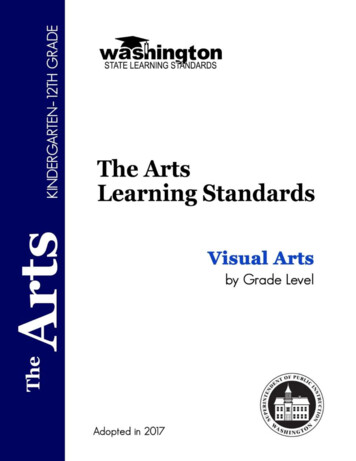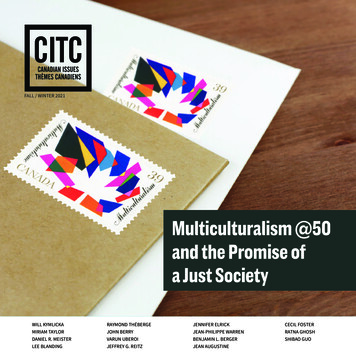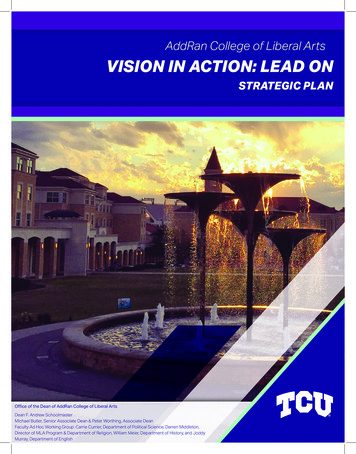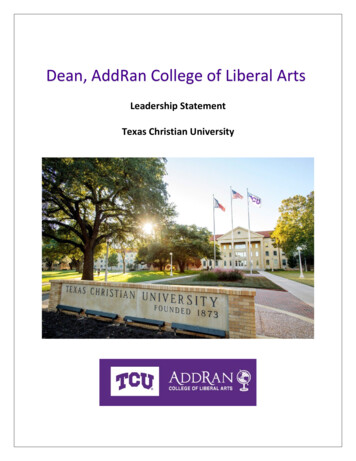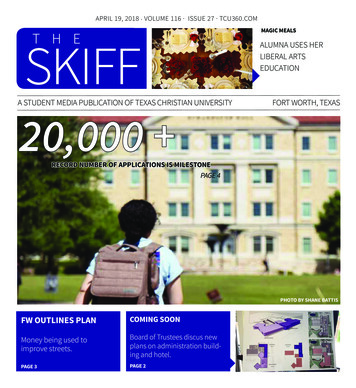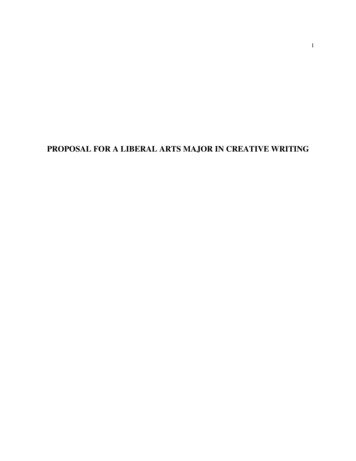
Transcription
1PROPOSAL FOR A LIBERAL ARTS MAJOR IN CREATIVE WRITING
2Table of ContentsAbstractI.II.III.IV.Program DescriptionA. What is Creative Writing?B. History of Creative Writing at Oakland UniversityC. Philosophy and PracticeD. Growth of the DisciplineE. Creative Writing at Oakland University at the PresentF. Programmatic Development of Creative Writing at OaklandRationale for the ProgramA. Creative Writing and Oakland University‘s Strategic PlanB. Creative Writing and the Goals of the College of Arts and SciencesC. Strategy for Development of the Creative Writing Major:Comparison with Other Institutions1. Michigan Universities2. Peer Universities3. Southeastern Michigan Private Institutions4. Big Ten Universities Outside MichiganD. Source of Expected StudentsE. Employment for GraduatesF. Advice and Consent45667789101010131920222223Self-StudyA. Current Status of Creative Writing within the Department of EnglishB. How the Goals of the Department of English Are ServedC. Faculty/Staffing NeedsD. Faculty QualificationsE. Impact of the Creative Writing Major on the English Major2324242526Program PlanA. Requirements for a Liberal Arts Major in Creative WritingB. Requirements for a Liberal Arts Minor in Creative WritingC. Program Honors in Creative WritingD. New Courses Proposed for the Creative Writing MajorE. Course Offerings in Creative Writing and EnglishF. Sample Four-Year for Curriculum Creative Writing MajorsG. Recruiting, Retaining, Advising and Monitoring StudentsH. Program Evaluation and Assessment2628282828363737
3V.VI.Cost AnalysisA. SBRC Budget Format37Implementation: Five-Year PlanA. Phasing in the ProgramB. Annual Increase in Library HoldingsC. Equipment and SpaceD. Director and Graduate Student Budgetary ItemsE. Implementation of New Internal ProceduresF. Predicted Enrollment LevelsG. Steady State of Operation39404040404141VII. AppendicesA. The Association of Writing Programs GuidelinesB. Sample Syllabi for New Courses Proposed1. ENG 2162. ENG 2173. ENG 3344. ENG 3355. ENG 3886. ENG 4097. ENG 413C. Oakland University Assessment PlanD. Library ReportE. Accomplishments of Recent GraduatesF. Current Full-Time Creative Writing Faculty VitaeG. Letters of Support: Departments of Art and Art History,Communication and Journalism, Writing and Rhetoric4250505865697378869698102153
4ABSTRACTInstruction in the craft of writing fiction, poetry or drama has been a part of American highereducation for nearly a century, since the University of Iowa created its Writers‘ Workshop.Since then, creative writing has become an increasingly popular addition to English departmentsacross the country: forty years ago there were thirteen institutional members of the AssociatedWriting Programs (AWP, the national professional organization that supports programs increative writing); today more 500 colleges and universities belong to the AWP and offer classesin creative writing; 159 of these institutions offer a B.A. or B.F.A. in creative writing. Theactive study of technique, form, style, genre and tradition made possible by course work increative writing provides a natural compliment to the critical study of literature, so that programsin creative writing are typically housed in departments of English, providing both professionaland academic education for students who are interested in the field. A degree program inCreative Writing is a definite extension of Oakland University‘s mission, which—according tothe 2020 statement—aims to provide opportunities for Oakland students to engage in ―creativelearning‖ and experience ―creative empowerment.‖The Department of English recommends that Oakland University grant a liberal arts Bachelor‘sDegree (B. A.) in Creative Writing. This recommendation is based on the popularity of creativewriting programs at both the undergraduate and graduate level, but derives particularly from theinterest in creative writing expressed by students at Oakland and the need for a degree programin creative writing at the local level. While creative writing workshops are routinely offered byall institutions of higher education in Michigan, only two schools in the region, Eastern MichiganUniversity and Saginaw Valley State University, offer degree programs. Oakland Universitywould meet a considerable local demand by granting a B.A. in Creative Writing, and Oakland‘sB.A. will have a particular character. As opposed to a B.F.A. in creative writing, which mighthave a more exclusive studio or workshop component, we propose a B.A. which will include arigorous academic schedule; we make this proposal in light of the recommendation put forth bythe AWP, that new programs somehow distinguish themselves from already establishedprograms. Students who major in creative writing at OU will be expected to take roughly half oftheir credits in academic courses. The 20-24 credits in creative writing workshops that ourprogram will require fits the national norm, but the academic component of the major wepropose helps set our program apart from creative writing majors that already exist in Michigan.In addition, it supports a long-standing tradition of creative writing at OU, where instructors witha Ph.D. (as opposed to a M.F.A.) have always been expected to conduct a wide range of classes,of both a creative and scholarly nature.
5I.Program DescriptionA. What is creative writing?Put most simply, courses in creative writing provide instruction in the appreciation andproduction of literature. Although the term ―creative writing‖ used by Emerson in ―TheAmerican Scholar,‖ in 1837, designated a respite from—in his words—the ―emendators‖and ―bibliomaniacs of all degrees,‖ and creative writing was not incorporated intocurricula until the first classes in writing pedagogy were offered at Harvard in the1880‘s,the study of literature and the practice of writing literature are fundamentally related.Fifty years after writing was first taught at Harvard, a program of study was formalized atthe University of Iowa, and since that time the teaching of creative writing has come tohold an important place in English departments throughout the country. Today,according to the Associated Writing Programs (AWP)—the national organization thatpromotes and oversees instruction in creative writing—more than 500 colleges anduniversities currently offer a minor or major (B.A. or B.F.A.) in creative writing.Though Emerson pointed out a contrast between writing and other scholarly pursuits, therelationship between literary studies and creative work has been more often affirmed.Literature and writing can function as a unifying lens for all of undergraduate education.We all see our lives and our identities in terms of narratives; we all use language toexpress ourselves and to communicate our desires and needs and fears to others in theworld. Moreover, we know ourselves through the stories we tell ourselves. We read andreturn to the stories we half-consciously construct for ourselves (about why we behave aswe do); the stories told to us by our parents and other community-members (about whythe world is the way it is)––all of these help to shape who we are. These stories also helpto determine what we can imagine ourselves doing in the world, both in the present, andin the future. In other words, the extent to which we can act and effect change isdetermined by our imagination, by our ability to tell ourselves new and different stories.Literature historically also serves as a record of the thoughts and feelings, the political,cultural, and technological changes on-going in the societies of its authors, and reflectsthe complex engagement of individuals with larger historical forces. Literature providesus with the most evocative and illuminating picture of vanished societies, as well associeties that are foreign to the readers. In a sense, literature can help to bring peoplesvery different from one another into harmony. We can see people from other cultures ashuman and sympathetic when we read novels such as The Kite Runner. Literature helpsus to imagine worlds and human situations very different from our own.Creative writing programs provide the opportunity to students to add their voices to theglobal conversation. As youngsters in grade and high school, many students instinctivelyturn to poetry and fiction to express their own longings and fears. The Creative WritingProgram gives them a venue that assures them (because their professors firmly believe)that their voices are as important as the voices of great writers. Their work may be at anascent stage, but they are engaged in the same task as that of Shakespeare and Jane
6Austen: they are trying to express the inchoate feelings and thoughts that simmer insideall human beings. They are motivated by a desire to communicate with the world. Thisdesire and the ensuing attempt to grapple with language as an expressive medium, is oneof the most important components in the education and development of young minds. Asa consequence, being heard is essential to the process through which students becomeresponsible, engaged adults, and caring, thoughtful citizens of the world.B. History of Creative Writing at Oakland UniversityCreative Writing has long had a place in the English Department. Tom Fitzsimmonstaught Introductory and Advanced Poetry and Fiction courses until the winter of 1988,when he left the university. Edward Hoeppner arrived in the fall of 1988, and taught thesame set of courses for two years. After that he began teaching Poetry and FictionWorkshops as separate courses on alternate years, and through the next ten years he wasthe sole writer teaching these popular courses. In the Winter of 1999, Maureen Dunphy,an adjunct professor, began to teach Introduction to Fiction Writing. The following fallsaw the arrival of Gladys Cardiff, a poet, and Annie Gilson, a fiction writer: their hiringmade it possible for the Department to staff both the introductory and the advancedsections of poetry and fiction workshops every year. In 2004, Maureen Dunphy left theuniversity, and Annie Gilson began teaching fiction writing in the summer, though eventhese additional offerings did not satisfy the demand for the course. In order to meet someof the need for more creative writing courses, the English Department then began crosslisting Introduction to Playwriting and Advanced Playwriting, taught by Kitty Dubin inthe Department of Music, Theatre and Dance. The Department also began hosting acreative writing conference, The Far Field Writers‘ Conference, which it continued tosponsor for seven years.In the fall of 2008, the English Department brought in another adjunct professor, DawnNewton, to teach Introduction to Fiction Writing, filling a need generated greater studentinterest in this particular course and by the departure of Maureen Dunphy (in 2004). Thefirst section of Screenwriting was offered the following year, taught by another adjunct,Doris Runey. In addition, the Department hired a new assistant professor specializing infiction, Jeff Chapman, to help build the program and address the demand for creativewriting; he began teaching in the fall of 2009.C. Philosophy and PracticeCreative writing embraces many sub-divisions of literary art, from traditional genres suchas poetry and fiction, as well as literary nonfiction, playwriting, and screenwriting, tonewer, more experimental genres such as prose poetry and graphic novels. All theseforms are aesthetic and intellectual disciplines that develop students‘ knowledge of thetraditional genres, styles and uses of language, drawing on the long history of aestheticand formal compositional strategies, and helping students to understand how best tocommunicate with and emotionally affect their audience. Successful creative writing thus
7requires careful study of other literary works, analysis of how these works achieve theireffects, an immersion in craft (to give students the hands-on experience of practicing theirchosen genre) and the provision of a workshop environment to help developing writersunderstand how literary effects are achieved by exploring the dynamics of audienceresponsiveness.D. Growth of the DisciplineThe Associated Writing Programs (AWP) provides figures that dramatize the growth andpopularity of writing programs across North America. They note on their m):From 13 member colleges and universities in 1967 to 500 institutional members today,AWP's institutional membership has grown with the growth in the number of programs.The following table quantifies the growth of writing programs and AWP's expansionalong with them. The numbers of degree-conferring creative writing programs are takenfrom The AWP Official Guide to Writing Programs, which became a free web-basedpublication in 2007.Growth of Creative Writing ProgramsYearAABA/BS minorBFA/BA 5197502433215579Joseph M Schuster, in an overview of the growing popularity of Creative WritingPrograms, notes (http://www.webster.edu/ schustjm/creative.htm) that ―[t]he most recentstatistics available from the AWP, from the early 1990s, showed that, among the 180member institutions it had at the time, there were close to 10,000 students enrolled asundergraduate majors in creative writing, or as candidates for M.A., M.F.A., or Ph.D.degrees. While the organization has not done a similar census more recently, its total ofmember institutions has increased by two-thirds, suggesting that the number of studentsenrolled in programs that belong to the organization is substantially higher. The AWPpresently has 16,000 individual members.‖
8E. Creative Writing at Oakland University at the PresentCurrently, the Department of English at Oakland University emphasizes Poetry andFiction Writing (we also offer Creative Nonfiction and Screenwriting, though not in theIntroductory and Advanced Workshop format). We envision the new Creative WritingProgram at Oakland University offering three workshops in each of four genres (fiction,poetry, screenwriting, writing for television). The major will be divided into twotracks—poetry/fiction and television/screenwriting—and majors will specialize in one ofthe genres within these tracks: that is, students will specialize in fiction or poetry orscreenwriting or writing for television.The proposed Creative Writing major is a B.A. program, as opposed to one granting aB.F.A. While the B.F.A. is considered a pre-professional degree, the B.A. is a liberal artsdegree, fitting in with Oakland‘s commitment to providing broadly-based educationalfoundations. In addition to the courses required to complete the major, Creative Writingstudents must also take at least 20 hours of literature courses offered by the EnglishDepartment, since no student can become a skilled and effective writer without also beinga good reader.All Creative Writing faculty at Oakland University, in addition to being engaged andexcellent teachers, must be actively publishing in at least one area of specialization. Thisis critical to the major in Creative Writing. Writers can be role models for their studentsbased on the depth of their own creative inquiry, the seriousness of their work ethic, andthe example of their transformation of thought into literary expression. Familiarity withthe world of publication, with the various journals and readings, conferences andprofessional magazines, is also invaluable in preparing students for graduate work and forprofessional successF. Programmatic Development of Creative Writing at OaklandThe teaching of Creative Writing is evolving dramatically in the United States, Canada,and Great Britain. Fifteen years ago, the M.F.A. was the highest degree granted; now,many candidates for jobs teaching Creative Writing have Ph.D.s. (The EnglishDepartment did a search for an assistant professor of Creative Writing in 2008-09 and, ofthe 12 candidates we interviewed at Modern Language Association‘s annual conference,10 had Ph.D.s in creative writing, while only 2 had M.F.A.s. Without exception, thosecandidates in possession of a Ph.D. were far more prepared to do academic teaching atthe college level than were the M.F.A.s. All three candidates who became finalists hadearned a Ph.D.)What this means on the undergraduate level is this: The increase of professionalizationwithin the Creative Writing field requires that students who are interested in going on toearn higher degrees in the field of Creative Writing should announce their specialization
9and hone their skills earlier in the course of their academic careers. Indeed, entry into anM.F.A. program (let alone a Ph.D. program) has become increasingly competitive.To better serve our students, the Department of English at Oakland University plans toimplement the B. A. in Creative Writing and to add to it, several years from now, anM.F.A. in Creative Writing. Currently, in southeastern Michigan, Albion College,Wayne State University, Eastern Michigan University and the University of Michiganoffer the B.A. in English with a Creative Writing concentration; these programs oftenfeed into the M.A. or M.F.A. degrees offered by all of these schools (with the exceptionof Albion). By offering the B.A. in Creative Writing, Oakland University can distinguishitself from other colleges and universities in the region: at this time the EnglishDepartment cannot offer enough courses to satisfy the interests and needs of ourundergraduate majors, but the new major in Creative Writing, since it requires aconsiderable amount of academic work, should help provide for our undergraduates inEnglish and Creative Writing and pave the way for the implementation of a graduateprogram at Oakland.II. RATIONALE FOR THE PROGRAMA. Creative Writing and Oakland University’s Strategic PlanThe institution of the Creative Writing major at Oakland University will correspond withthe following components of Oakland University‘s ―2020 Mission‖:National UniversityThe creation of a B.A. program in Creative Writing will further Oakland‘s efforts toposition itself as a national university by broadening the University‘s liberal artsspecialties through the addition of top faculty members in the writing of poetry,fiction, screen and television writing and by expanding its curricular offerings inliterary modes and special topics related to the discipline of English literature. Inaddition, the highly successful annual Maurice Brown Memorial Reading and yearlyfiction readings will continue to bring nationally renowned and emerging writers tocampus for public readings and workshops with an enhanced and expanded emphasison classroom visits and master classes and coordination with other cross-disciplinarycollaborations and campus events. These events are enormously popular and wellattended enrichments to the cultural and social atmosphere on campus for students,faculty and staff, and the surrounding community. Such a campus environment willposition OU as a destination school for future students, scholars, and community andindustry leaders.Community Engagement and PartnershipsPer the 2020 Mission‘s goal, the Creative Writing program will provide opportunitiesfor Oakland University students to engage in ―creative learning‖ and experience―creative empowerment.‖ Creative Writing is traditionally associated withcommunity outreach and global diversity by communicating in a public sphere suchas readings and lectures a variety of aesthetic viewpoints related to literary, ethnic,
10cultural, and other influences. Furthermore, as recently initiated programs, includingthe Michigan Film Incentive, Rochester‘s Downtown Development Authority, andOakland University‘s new film studies program, expand cinema culture within ourcommunity, the Screen and Television writing track of the OU Creative Writingmajor will actively ―create and expand experiential opportunities for OU students‖ bytraining our students in a growing local industry.A Student-Centered Learning ExperienceFinally, the typical course design, assignment structure, and learning objectives ofCreative Writing courses, as well as the emphasis on both close reading and criticalanalysis of a diversity of literature and literary modes within the major, will help toproduce the type of students described in OU‘s ―student-centered learning‖ objective:―Graduates entering the workplace will be able to think critically and creatively,communicate effectively, manage and use information technology, and interact wellwith others.‖B. Creative Writing and the Goals of the College of Arts and SciencesThe proposed Creative Writing major meets many facets of the ‗Tactics‘ articulated by theCollege of Arts and Sciences (http://www2.oakland.edu/cas/characteristic.cfm). First, a B.A.in Creative Writing provides several of the educational priorities proposed by the College,including the opportunity to engage in both academic research, via the Critical Studies,Poetics, and Literature requirements, and artistic creation, via the Workshop and Portfoliorequirements and, we hope in the future, a University sponsored literary journal with nationaldistribution. Second, the diverse Creative Writing curriculum offers the broad range ofdisciplinary perspectives that are valued by the College in its Mission Statement. Third, withits emphasis on aesthetics and genre and the practical application of craft techniques inoriginal writing, the creative writing major will present students with numerous opportunities―to understand and appreciate how culture and the arts enrich and inform all aspects ofhuman endeavor.‖ This goal will be further enhanced via future internship opportunities andstudents‘ participation in the organization and execution of special programs. Fourth, thecultural events we offer will foster and sustain an environment on campus where creativework can be appreciated by all members of the OU and greater Oakland community and, as aresult, assist the College in ―[creating] a culture where students embrace the arts and usethese experiences to develop and enrich their personal and professional philosophies.‖C. Strategy for Development of the Creative Writing Major: Comparative InstitutionsMany public and private universities in southeast Michigan support some sort of enhancedundergraduate curriculum in creative writing. However, only 2 of the 14 public Michiganuniversities (Eastern Michigan University and Saginaw Valley State University) currentlyoffer a B.A. in Creative Writing. Of the remaining 12 universities, 7 offer Creative Writingas an area of concentration with an English major. Six universities offer a Creative Writing
11minor. We believe that, for Oakland, this presents a significant opportunity to attract studentswith an interest in this discipline.BA in Creative Writing program (or related) undergraduate majors at peer, Michigan, andBig Ten institutions:MichiganUniversitiesCMUConc. Minor B.A. B.S. M.F.A. oNoNoGVSUYesYes*NoNoNoEnglish B.A. or B.S. with Concentrationin Creative Writing. 21 core Englishcredits. 18 advanced creative writingelective credits. 9 credits must befocused on poetry, prose, or both.Major: 124 hours total. 27 hours ofrequired core courses. Creative Writing& Writer‘s Workshop must be takentwice. Topics include Poetry, Fiction,Creative Nonfiction, Mixed Media,Sound Poetry, Performance Poetry,Performance Writing, Hypermedia,Lyric Essay, Translation, WritingEnvironments, Experimental Prose,Collaboration, Mixed Genre, Collage,and ‗Zines.9 hours in restricted elective courses.Minor is required-students encouragedto minor in philosophy, art, and drama.Minor is 21 hours, including 9 hours ofCreative Writing and Writer‘sWorkshop. (1 must be repeated asdifferent topic)Minor requires 18 credits and cancompliment any baccalaureate degree.B.A. in Writing with option of twoconcentrations-Professional Writing orCreative Writing. 42 major credits: 12from the core, 27 from the track and 3from the capstone. Students choosecourses in two of the four genre groups:poetry, fiction, drama, nonfiction.Capstone: Genre and Writing.*Writing minor: broad curriculumincluding professional and creativewriting courses. Requires 18 credits.
NoNoNoYesSVSUNoYesYesNoNoU of MYesNoNoNoYesB.A. in English with Creative Writingconcentration. Students choose three ofthe five available genres of introductorycreative writing courses: Creative NonFiction, Fiction, Poetry, Playwriting,Screenwriting. Students then choosetwo genres to take advanced courses in.36-40 total English credits required.B.A./B.S. in English Writing. Totalcredits: 124. Total Major credit: 41.Students required to complete 12-20credits in two of the followingconcentrations: Journalism, Fiction,Nonfiction, Poetry, Technical Writing,Drama, Media Writing.Writing Minor requires 20 credits.39 Major Credits required. 15 credits ofcore classes. 21 credits in electivecategories. Students must take onecourse (3 credits) from each of thefollowing categories: Introduction toWriting, Backgrounds to Literature,Applied Writing, Language, LiteraryGenres, Literature, Concepts in Writing.Minor is required.Creative Writing Minor: 18 creditsrequired. 15 credits in required coreclasses. One course chosen fromCreative Writing: Poetry or CreativeWriting: Fiction.Creative Writing is an optionalconcentration within the B.A. inEnglish. Students who are interested inthis concentration are advised to enrollin ENG 223: an introduction to thereading and writing of poetry and prose.After this introductory course, studentscan enroll in intermediate courses in thegenre of their choice: fiction or poetry.Students may apply to the CreativeWriting Sub-concentration during the
13winter term of their Junior year. Onceaccepted, students compile a majormanuscript of poetry or prose fictionduring their last term. The program issmall and selective. Students notenrolled in the sub-concentration maystill pursue their interest in creativewriting by applying to the appropriateupper-level workshops.The Residential College, a section of theCollege of LSA, also offers a creativewriting and literature program, aconcentration within the RC curriculum.Students must complete at least fourcreative writing courses and fiveliterature courses, at the 300 level, thatmodel the genre they are pursuing intheir writing.U of M-DU of oYesThe curriculum for the B.A. in Englishis currently being revamped for the2009-2010 school year in order to offerconcentrations, Creative Writing beingone of the tracks. Currently, creativewriting courses are offered and studentshave the option as taking them as theirEnglish electives.Creative Writing concentration for anEnglish major. 34 Major hours. 4credits: Writing Fiction and Poetry.Students must choose 2 courses (6credits) from the following: AdvancedFiction Writing, Advanced PoetryWriting, Playwriting, Writing CreativeNon-Fiction. (Students may repeat anyof the courses one time). Students musttake 4 credits in Creative WritingWorkshop focused on one of four genreslisted above. 13-14 hours of Literatureand English Language Courses. One
14additional literature or English languagecourse at 2,000 level. Two semestersof foreign language requirement.2 of the 14 public Michigan universities (Eastern Michigan University and Saginaw Valley StateUniversity) currently offer a B.A. or B.S. in Creative Writing. Of the remaining 12 universities,7 offer Creative Writing as an area of concentration with an English major. 6 universities offer aCreative Writing minor.PeerUniversitiesWichita StateUniv.Conc. Minor B.A.B.S. M.F.AAdditionalNoYesYesNoYes33 hours of coursework. 12 hours ofEnglish core courses. 3 hours ofMajor Requirement: Introduction toCreative Writing--must completecourse with grade of B or better orreceive departmental consent forfurther course work. At least 12hours of Skill Requirements coursesfrom following: Fiction Writing,Poetry Writing, Creative NonFiction writing, Fiction Workshop,Poetry Workshop, Playwriting I,Playwriting II, Writer‘s Tutorial:Prose Fiction, Writer‘s Tutorial:Poetry. (Except for first three, allcourses may be repeated once forcredit). 6 Hours of upper-divisionelective courses in department.Minor: 12 hours. 3 hours Intro toCreative Writing. 9 hours of skillcourses.Univ. ofNevada-LasVegasUniv. ofAkronNoNoNoNoYesNoYesNoNoYesMinor in Creative Writing: 2introductory courses from thefollowing: Poetry, Fiction, Script. 1
15ClevelandState Univ.YesNoNoNoYesIndiana StateUniv.NoYesNoNoNoUniv. OfMissouriYes*NoNoNoYesWright StateUniv.Ball advanced course in one genre. 1literature course. 2 Englishdepartment electivesCreative writing concentrationwithin B.A. of English. 38 credits. 8credits of introductory courses: Introto Poetry and Intro to Fiction andDrama. 4 credits of CreativeWriting. 8 credits in CreativeWriting Workshop: Fiction, Poetry,Playwriting, Special Topics. 14credits in 300 level courses. 4credits of senior seminar.Creative Writing Minor: 18 hours. 3hours: Contemporary Literature forWriters. 15 hours selected fromintroductory courses and workshopsin the following genres: Fiction,Poetry, Creative Nonfiction, Drama,Playwriting.*Creative Writing Certificate whichcan be obtained by completing 18hours of required courses. Must takeat least two of the following courses:Poetry Workshop, FictionWorkshop, Advanced PoetryWriting, Advanced Fiction Writing,Writing Internship, Editing Litmag(Department creative writingjournal)Concentration (Option) within B.A.of English. 48 hours. 21 hours ofRequired Courses: Intro English,Language and Society, Writingabout Literature, Intro to CreativeWriting, Special Topics in CreativeWriting, Creative Writing in theCommunity, Senior Seminar. 15ho
all institutions of higher education in Michigan, only two schools in the region, Eastern Michigan University and Saginaw Valley State University, offer degree programs. Oakland University would meet a considerable local demand by granting a B.A. in Creative Writing, and Oakland's B.A. will have a particular character.
